Beyond the Banks: A different view of the Daintree River
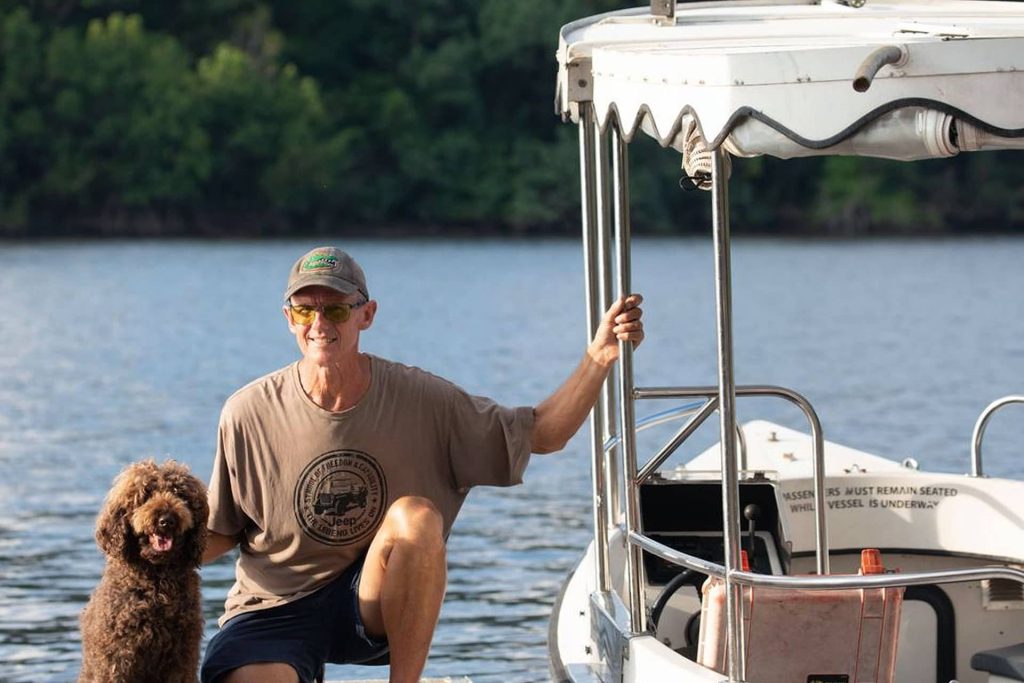
David White alongside the Solar Whisper river boat. © Cairns Post
A new year is perfect for gaining a fresh perspective. Today it’s time for sharing the Daintree River’s viewpoint, as we experience the rainforest from the water.
It’s now one year on from the devastating floods that followed Tropical Cyclone Jasper, when record-breaking water levels and rainfall had a profound impact on the Daintree community and the surrounding natural environment.
Recently, we took time to chat with David White, founder of ecotour Solar Whisper Wildlife and Crocodile Cruises, and a long-time supporter of Rainforest Rescue.
David experiences the Daintree from the river every day, so he is perfectly placed to witness the changes and impacts that the river and rainforest navigate. Understandably, David’s passion runs deep, with over a generation spent on the river as a guide and steward of this magnificent waterway.
Here we share his thoughts on the state of the Daintree as he sees it firsthand, and what he believes must happen next to support the future of this special region, especially in the wake of a catastrophic wet season.
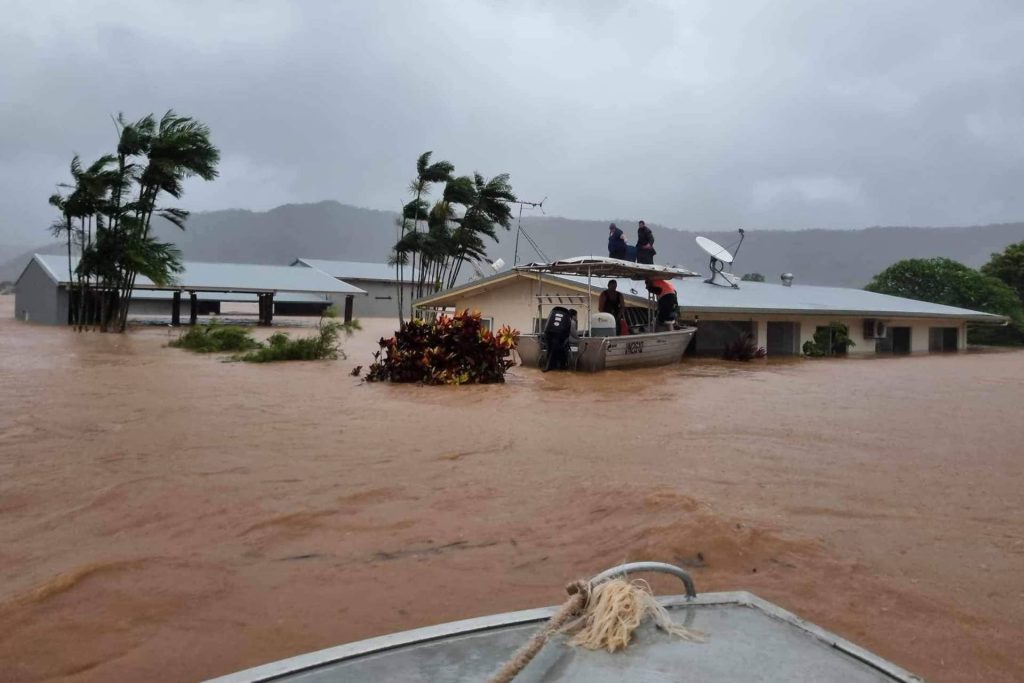
Local communities affected by the aftermath of Tropical Cyclone Jasper at the end of 2023. © David White
Surviving Jasper
Rainforest Rescue: Hi David, it’s great to see you. 2024 was a tough year in Far North Queensland following Tropical Cyclone Jasper. How have you fared?
David White: Thanks for asking me, I appreciate it a lot. You’re right, it’s been difficult for everyone up here. Right now, many people in the Daintree and wider Douglas Shire are keeping a very close eye on the weather radars as we’re in the wet season and the flooding risk is present.
This time last year I was shovelling mud out of the Solar Whisper office, we went without power or water for many days as our community suffered the worst flood on record.
RR: That’s tough to hear, David. The cost to repair and get the community and infrastructure back on its feet again has been in the many millions of dollars. Was this a one-off natural disaster?
DW: No, and I don’t think it’ll remain that way either. I don’t think people around the country realised just how bad it was in 2023/4. The Daintree region flooded the previous year too. The toll it takes is not just on our communities here but on the local wildlife and the natural environment.
Unfortunately, this year and last year due to the floods, from what we can tell, almost all the baby crocodiles died. Now we have to wait another year to see the new broods. For me this is such a long wait and really devastating.
RR: How does this happen? Aren’t crocodiles able to survive the flooding events?
DW: The big crocs cope OK with the sudden surges in water levels, although the river turbulence can be pretty vicious. It’s the younger, smaller crocs and the babies, especially the eggs, that suffer. Nesting season coincides with the wet season, the nests are away from the water line, on a bank or sheltered amongst the tree roots. But a big flood will take the water level up to the nests and literally drowns the eggs. The embryos ‘breathe’, so they are vulnerable to waterlogging. It’s awful to witness, knowing where the nests were and then they vanish.
Now imagine that happening for all the species smaller than the massive saltwater crocs – the turtles, frogs, birds, mammals, even the insects and invertebrates – just getting smashed by this force of water over a sustained period. It was a difficult start to the year for many ‘Days of the Daintree celebrities’ following heartbreaking losses of the nests. But it wasn’t all sad news. As this year also revealed some new ‘celebrity pairings’, much to the delight of their fans.
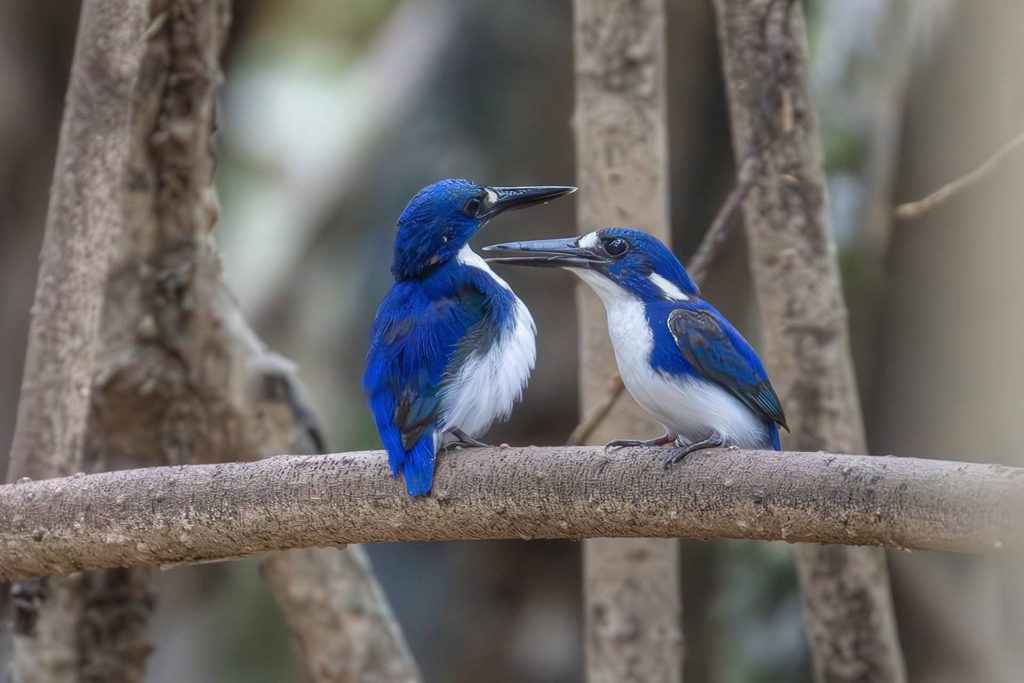
Little Kingfisher Millie and her beau Marley were spotted sharing a meal on Valentine’s Day. © David White
A different Daintree River
RR: This is really difficult to take in, David. We know how much time you spend out on the water, your ‘Days of the Daintree’ posts on social media are like a soap opera of the wildlife on the river. Are you saying that you’re witnessing the river changing?
DW: Yes. The riparian vegetation has all but gone in many places and it’s very sad to see. The river has changed so much from the 2023/4 flood, and it’s been a real shock to witness, not just for me but for the people visiting and the community too.
In my time, well over 20 years on the river, the wildlife population has deteriorated greatly as well. We have literally no wetlands left. I can’t believe how much bird life has decreased and seeing the wetlands in the Northern Territory only made the difference more dire.
The river is devoid of most of its riparian vegetation, and its regular basking spots for the crocs, now we just see farmland. It is heartbreaking to experience.
The riparian vegetation has all but gone in many places and it’s very sad to see.
RR: For our supporters this will be challenging to read. What is causing this destruction of habitat, David?
DW: The back-to-back floods have cleared so much of the vegetation along the riverbanks, however it was a problem before this. Unfortunately, there is next to no riparian land left between the Daintree and the zoned land along the river. I’m concerned that farmers and landowners will start to lose their land as there is no buffer zone anymore with trees stabilising the bank, slowing the water flow and providing habitat for wildlife. The river is literally eating the land away!
Of course, rivers meander over time, and the levels change with the seasons – there’s even an oxbow lake just south of where the Daintree used to flow – but this is not the river that we’re used to.
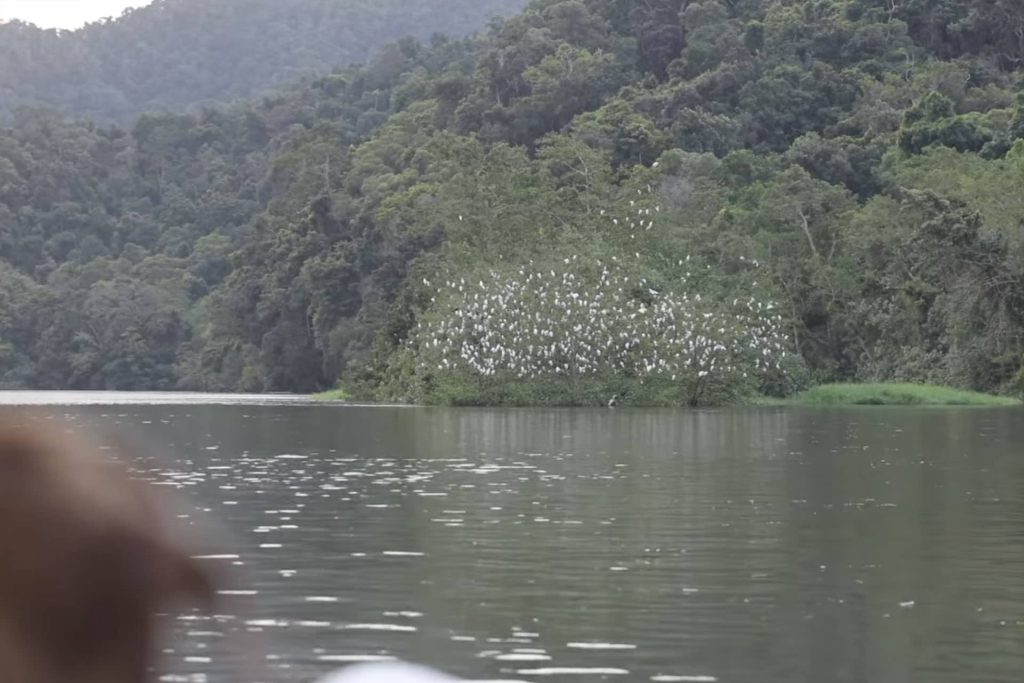
Approaching Lafferty Island, before its devastation by Tropical Cyclone Jasper. © David White
Time for action
DW: One of my favourite places on the river to go to after work was Lafferty Island or ‘Bird Island’. It’s where all the egrets and other waders roosted, full of life and commotion, crocs used to hide in the marsh grass as well.
After the massive flood in 2023 I expected it to be damaged. But I sure as heck didn’t expect this! Every single tree is uprooted and gone completely. All that’s there now is a sand bar.
RR: The difference is astonishing. The Low Isles are almost opposite the mouth of the Daintree River. Our team has seen firsthand how the sediment from the river was carried over 15km out to these islands by the floodwaters and is now covering the fringing coral reef. What’s going to make a positive difference?
We urgently need an intervention of some kind to ensure there’s a riparian zone.
DW: Some people say, ‘don’t worry, they (the trees on the riverbanks) will grow back’, but what they’re overlooking is that there’s no land as it’s been washed away. In many locations it’s just private land and river – there’s not space available to recreate this buffer. We urgently need an intervention of some kind to ensure there’s a riparian zone.
People are shocked by what they see on the river. This is the gateway to a World Heritage Area. It’s time we rectified this.
Slowing down the erosion of the riverbank is critical. The riparian land needs revegetating – regrowing the root systems in place to hold the soil and reinstate the integrity of the watercourse. For example, farms don’t need to be right at the edge of the river, nobody wants to lose their cattle to a croc! With the closure of the sugar cane mill, we have an opportunity to rethink what we’re using the land right along the edge of the Daintree for. It’s a great time to be working together as a community to put solutions in place.
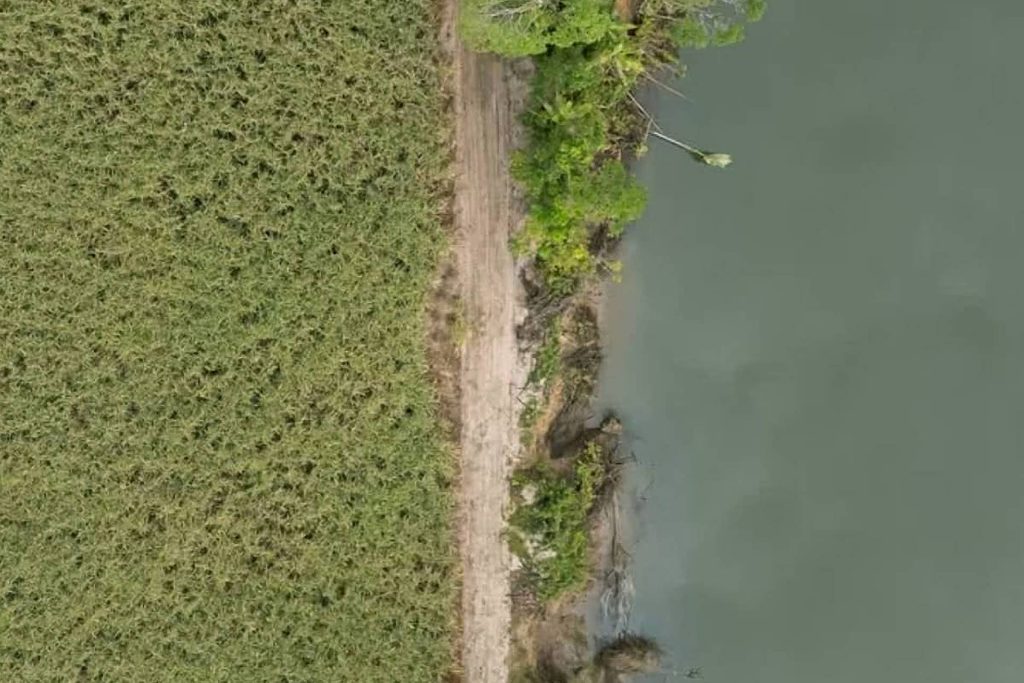
Daintree River’s proximity to farmland as the riparian zone continues to erode. © David White
Stewardship for survival
RR: Your words are a real motivation to us, David. Trees are the answer! And with that, appropriate stewardship of the land – so that nature and people are able to live harmoniously. Initiatives like the Queensland Government’s Land Restoration Fund are incentivising landowners to restore native vegetation, which is an ideal fit for the riparian zones along the Daintree River.
DW: Yes! We have had a few lessons up here in the north lately and Mother Nature showed us who the real boss is. I believe need to start looking after her better in this country as a whole.
We also were given some other lessons, including one that restored my faith in humanity and that was the phenomenal community spirit that was everywhere. The best of humanity – compassion, generosity and kindness came out in all her glorious colours. Seeing this humbled me. There were many unsung heroes in this disaster and what they did for others was selfless, just pure kindness. For all those still suffering, know that you matter, and we are thinking of you. For the rest of us we are thankful.
There were many unsung heroes in this disaster and what they did for others was selfless, just pure kindness.
RR: There is an incredible resilience in the face of adversity – many of our team were affected, some having to evacuate their homes in the floods. Disasters like the record flooding mean there is a real sense of urgency to take action on the ground up here.
DW: Undoubtedly. The river is the gateway and the meeting place of the Great Barrier Reef and the oldest rainforest on Earth and we’re not treating like this. In all honesty it’s embarrassing. It’s time we face up to this stark reality. We need major involvement, or the impact will continue to mount up.
Action is in the best interest for First Nations people, wildlife, tourism, community, public, those that love fishing (as healthy wetlands means healthy river!) and the farmers, as having property adjacent to the river can be very hard on them. So, this is about everyone working together for an iconic area.
RR: We’re with you, David. There’s so much to do to restore and protect this region’s rainforests, rivers and reefs – we have more than 25 years of work ahead of us all!
Rainforest Rescue is urgently raising funds to purchase, protect and restore land in the floodplain of the Daintree, creating a refuge for wildlife and habitat that can soak up the force of the floodwaters.
Solar Whisper’s Facebook page and Instagram feed are an ideal place to see the ever-changing dramas of the Daintree River, with many ‘celebrities’ making regular appearances. But they’re also a stark reminder of the damage from climatic events and the resilience needed for the environment and community to cope with them.
With thanks to David White and the team at Solar Whisper Wildlife and Crocodile Cruises. David was in conversation with Mark Cox, Communications Manager at Rainforest Rescue.
Want more good Rainforest news in your life?
Subscribe to our eNews | Follow us on Instagram | Like us on Facebook | Subscribe to our YouTube channel
Help Protect Rainforests Forever
Donate to Protect Rainforests Forever | Become a Rainforest Guardian for as little as $2 a month | Partnership Options

